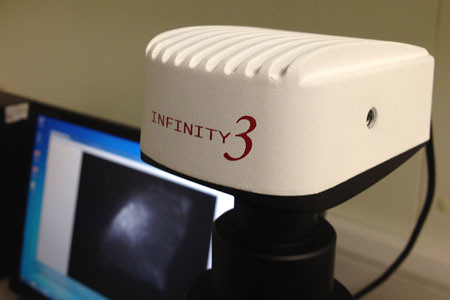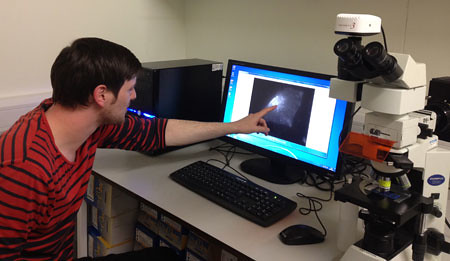A significant part of the scientific process is documenting what you observe. This activity is not merely a formality for the record. In some cases, it’s not until we study and analyze our results that the experimental situation can start to clarify.
In being charged with setting up a new cell biology lab, one of the first obstacles I hit was the state of our fluorescence microscope. It is a perfectly serviceable old beast, but it was lacking two essential components. First, it didn’t have a filter cube needed to detect red, one of the four major fluorescent color channels that cell biologists have in their palette (the others being blue, green and a wavelength known as “far red” that the human eye can’t see). Second and much more problematically, it lacked a camera to collect all the images. True, one of my young researchers was getting pretty good at aiming an iPhone camera down the ocular (which, if you’ve not tried this, is not dissimilar to playing a very frustrating video game), but this only worked well for white light.
Being cash-poor at the moment, I decided we could live without the red filter cube (which costs about a grand) for the time being. But something really needed to be done about the camera. A proper camera not only documents what you’ve done, but is a lot more sensitive than the human eye. Using its more discerning sensor, you can discover things about your experiment that you couldn’t by peering down the eyepiece. And so it was that we finally scraped together enough dosh — £4,000 including a PC and software to run it — to buy the cheapest decent CCD camera set-up that we could afford.
Behold the Infinity 3 — the most gorgeous piece of kit I’ve laid eyes on in a long time. She’s only about the size of my palm, but she packs a serious wallup. Respect.
Before the camera’s arrival, we’d do an experiment and then wait the week or so required to get a slot on a superior microscope housed on another campus, about thirty minutes away by bus. Normally when you do an experiment, you look down the scope straight away, take some pics, brew yourself an especially strong cup of coffee and process the images back in your office, looking at them with various image analysis tools and squeezing out every iota of information possible. Armed with that new knowledge, you can set up the next experiment – sometimes that very same day. So the research goes really fast when you have instant feedback. But if it takes a week to know if something worked properly, your research crawls along at a glacial pace – which in the current competitive climate, is deadly.
So the new camera is cheap, but pretty darned cheerful. Even Harry, my hard-to-impress MRes student, had to admit it took great pictures.
So now all I need is that red filter cube. You know what to get me for my next birthday.




*applause*
I do love a nice microscope. And I’m perpetually jealous of folks like you who get to take pretty, multicoloured photomicrographs of cells (even if red is MIA at the moment).
I’ve tried the “aiming a camera down the ocular” thing before myself – your description of this process as a “very frustrating video game” is perfect!. 🙂
You are cordially invited to do a sabbatical here in Omaha; we have our own in-lab confocal.
A minor correction: about 1% of the population can reportedly see the far red spectrum. I am among the other 99%…
Richard, looks as if we may have found funding for the red cube – huzzah!
Steve, I am agog. You can SEE far red? What does it look like? (Er, reddish?) I didn’t know humans could – how cool is that. And having your own confocal – well, I’m obviously drooling with jealousy. It must make a huge difference. And they cost as much as your average London house!
Jenny,
No, no. I am in the majority 99% who doesn’t see far red. But apparently 1% of the population DOES! I guess it does appear red, although maybe farther away?
As for our confocal: I can tell you it cost more than double my house, and the yearly service contract is about 3X more than my home insurance…
Sorry, wrong end of the stick! I’m fascinated by the far red thing – if any of my readers can see it, please do get in touch and let us know how it looks!
‘wallop’. Just sayin’.
As for the red business, I have this
theoryhypothesis about the color pink and why it’s generally associated with girls. No, don’t run away. It goes like this. Because many of the genes that make the color-sensitive cone cells in the retina are X-linked, color-blindness is a phenomenon usually seen in males. Conversely, it is possible for women, but not men, to have different alleles for red cones, which might make the experience of reds richer for females than males. I did have a reference to this somewhere but can’t trace it at the moment.Jenny,
If you want to know the limits of human vision in the infrared, I suggest you start with the following paper: Donald R Griffin, Ruth Hubbard and George Wald “The sensitivity of the human eye to infra-red radiation”, published in the Journal of the Optical Society of America, Vol 37 No 7, pp 546-554 (1947). I have it in the form of a reprint in a book on infrared detectors (this is the only paper in the book on human vision). More recent papers should cite it.
Henry, that assumes that pink wasn’t a boy colour until the turn of the 20th Century. Could explain why the British Army used to wear red, though.
Lovely with a camera! I too have been doing the “video game” thingy and it drove me crazy. The joy and relief when we got a camera in the lab…. wow..
As for the Red discussion> rpg, I think I read a paper on the impact of wearing red in sports, and that the winning team mostly has red shirts… something about being a signal for humans to run? Other option would be that red up until not too far while back was a sign of wealth (not as much as purple and royal blue but still harder to aquire than green/yellow/brown) so maybe the British Army wanted to show off?
(two references for the red thing> the Nature article one that I thought about> http://www.nature.com/nature/journal/v435/n7040/abs/435293a.html
and an article with lots of research linked to Journals http://www.spiegel.de/international/zeitgeist/the-annals-of-sports-psychology-winners-wear-red-a-570918.html
)
Very interesting stuff, guys. I am now *obsessed* with the idea that I might be in that 1%! I never even tried to look down the oculars at anything stained with a far-red dye, just because I assumed it was invisible. Next time I have a chance I am going to try to find out!
Yes, I know I don’t get out much.
The (consistently excellent) Radiolab podcast had an episode on colour vision recently and interviewed a woman who had super-sensitive colour vision (although as far as I remember they didn’t mention far-red). Highly recommended!
I prefer shades of grey, that’s why I do em. Proper colour vision is over rated anyway. 🙁
Don’t listen to those monochromatic EM guys–it must be all that PFA…
By the way, when I say I prefer shades of grey, can I make it clear that I don’t mean the book!
Fun stuff! As far as sabbaticals/summer trips go, you should head my way. I was wandering around my new home this week and stumbled upon an Apotome.2 with laser dissection and laser tweezers. I think it is time for you to take a road trip west. The lab is up and running at about 60%. By the summer it’ll be “full-steam ahead.”
Hey there! I just stumbled upon your page as a result of trying to figure out exactly how much of a freak I am – I’m one of those mutants who can see “far red”! My mentor had been telling me the difficulties in seeing one of the fluorophores we have because it’s not visible to the eye, but when I got a nice signal with it – well, it was obvious when I looked through the oculars. Very cool. It was a very vibrant red, as I saw it. 🙂
@Hanna Now you need to test for X-ray vision. If you have it, you can switch careers and become an airport security expert and make a lot of money…